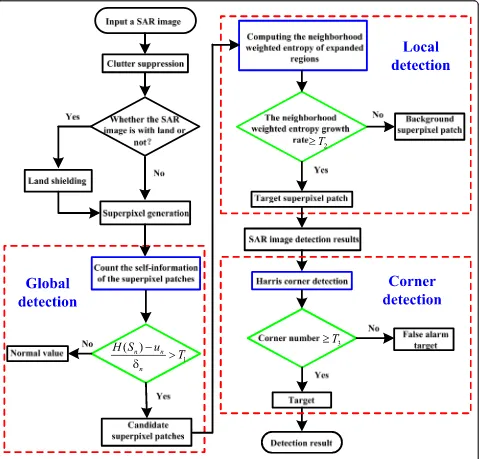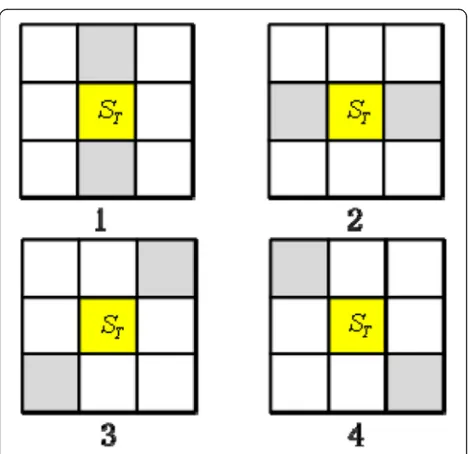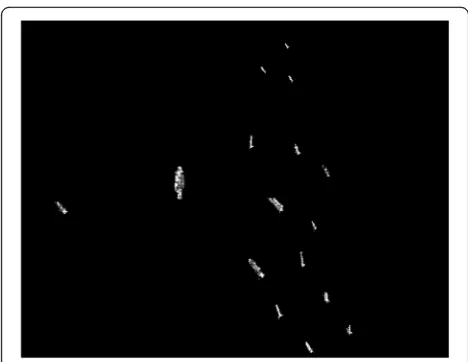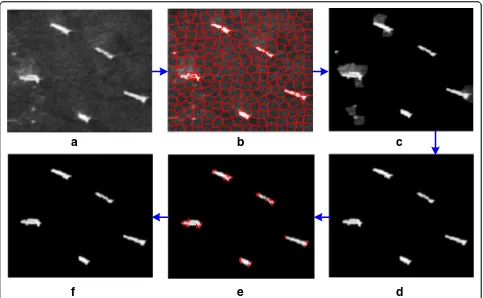R E S E A R C H
Open Access
Analysis of the ship target detection in
high-resolution SAR images based on
information theory and Harris corner
detection
Yangyang Deng
1, Haijiang Wang
1*, Shuo Liu
1, Min Sun
1and Xiaohong Li
2Abstract
In order to make up the shortcomings of some existing ship target detection algorithms for high-resolution synthetic aperture radar (SAR) images, a ship target detection algorithm based on information theory and Harris corner detection for SAR images is proposed in this paper. Firstly, the SAR image is pretreated, and next, it is divided into superpixel patches by using the improved simple linear iterative clustering (SLIC) superpixel generation algorithm. Then, the self-information value of the superpixel patches is calculated, and the threshold T1 is set to select the candidate superpixel patches. And then, the extended neighborhood weighted information entropy growth rate threshold T2 is set to eliminate the false alarm candidate superpixel patches. Finally, the Harris corner
detection algorithm is used to process the detection result and the number of the corner threshold T3 is set
to filter out the false alarm patches, and the final SAR image target detection result is obtained. The effectiveness and superiority of the proposed algorithm are verified by comparing the proposed method with the results of constant false alarm rate (CFAR) detection algorithm combined with morphological processing algorithm and other ship target detection algorithms.
Keywords:SAR image, Ship detection, CFAR, Superpixel, Information theory and Harris corner
1 Introduction
Synthetic aperture radar imaging is not limited by wea-ther, illumination, or other conditions. To carry out re-search on ship SAR target detection is very important for marine monitoring management and timely military information acquisition [1].
There are many methods for ship target detection, but the constant false alarm rate (CFAR) detection algorithm is most widely used [2]. Scholars have proposed some de-tection methods based on different statistical distribution model of sea clutter in SAR images, including the gamma distribution model, Weibull distribution model, and so on [3–5]. However, they are not independent on the clutter statistical model, and they are not robust. Moreover, CFAR detection methods are based on pixel-level
detection, and they will cause some false alarm detection targets. After the concept of superpixel is proposed, the target detection in SAR images based on superpixel has developed rapidly [6]. It uses the superpixel instead of the pixel as the processing unit, and it can obtain a better de-tection result [7].
In recent years, the idea of visual attention has been introduced into SAR target detection and it has obtained some good performance. Hou et al. [8] pro-posed a ship detection method in SAR images based on visual attention model according to the prior knowledge that ships are in the water region rather than on the land, the ship detection performance is well, and the ship detection performance can be im-proved even though there are still some false alarm targets and some lost ship targets in the detection re-sult. Liu and Cao [9] have combined the pyramid model of visual attention with singular value decom-position (VA-SVD) to detect the targets in SAR * Correspondence:whj@cuit.edu.cn
1College of Electronic Engineering, Chengdu University of Information Technology, Chengdu 610225, Sichuan, China
Full list of author information is available at the end of the article
images; however, the computation speed of the algo-rithm is very slow, and the detection performance is not very good when the SAR images have a large and complex scene. Wang et al. [10] proposed a visual attention-based target detection method for high-reso-lution SAR images in complex scenes; even though the detection rate in complex is high, the original morphology of the targets cannot be well preserved in the final detection result.
As for the detection method based on information, Cao et al. [11] proposed a fast target detection method for high-resolution SAR images based on variance weighted information entropy (VWIE), and Wang and Chen [12]
have used the method based on multiscale variance weighted image entropy (MVWIE) method to detect the ship targets in the complex background SAR images. They are proved to be effective to detect the true targets suc-cessfully; however, the discrimination of the target and the surrounding cells is difficult, and there are usually some false alarm targets in the detection result.
In order to improve the detection performance of the existing ship target detection method for high-resolution SAR images, a ship target detection algo-rithm based on information theory and Harris corner detection for high-resolution SAR images is proposed in this paper.
The remainder of this paper is structured as follows. Section 2introduces the detection method based on in-formation theory and Harris corner detection. Section3 shows the details of our experiments and gives the result analysis based on the proposed method. Finally, the con-clusion is given in Section4.
2 Methods
The proposed detection method consists of three stages, including the global detection, local detection, and Har-ris corner detection, as illustrated in Fig.1.
2.1 Superpixel generation algorithm
At present, the superpixel generation algorithms such as watershed algorithm, mean shift algorithm, and K-means algorithm are widely used in the op-tical image processing. For ship target detection in SAR images, the subsequent processing will be easier if the edge of the superpixel patches can coincide or almost coincide with the edge of the targets in the SAR image. The simple linear iterative clustering (SLIC) superpixel generation algorithm [13] which is based on clustering can meet the requirement mentioned above. However, because the SLIC algo-rithm is used for optical image processing, without considering that the SAR image is the gray image, the color distance of an optical image must be ad-justed to the grayscale. The other steps are the same as the SLIC algorithm.
2.2 Self-information of SAR image
In the information theory, the self-information of a ran-dom eventeiis defined as:
H eð Þ ¼i −logmp eð Þi ð1Þ
Among the expression, p(ei) is the occurrence
prob-ability of the random event ei, and the variable i
repre-sents the ith possible event. If the base of the above logarithm is 2, the unit ofH(ei) is bits.
For any superpixel patchSn in SAR image I, assuming
that the superpixel patch is composed of a×a pixels, the intensity distribution model of Sn can be expressed
by the following formula:
Among the expression, the variablep(r) represents the probability of the pixel whose grayscale intensity value is r. The likelihood function is used to express the prob-ability of each superpixel patch. Its conditional probabil-ity value is:
P Sð njΙÞ ¼ Π a2
k¼1PIðSnð Þk Þ ð3Þ
In the expression, PI(•) is the probability distribution
of the SAR image I, andSn(k) is the corresponding gray
value of the kth pixel. Because the order of pixels in superpixel patches is not considered, the upper expres-sion can be represented by the probability distribution of superpixel patchSn.
P Sð njΙÞ ¼ Π
Fig. 2The four extended neighborhood
Substituting Eq. (4) to (1), the corresponding self-information of the superpixel patch Sn can be
ob-tained, as illustrated in the following expression:
H Sð njΙÞ ¼−logmðP Sð njΙÞÞ ¼−logm Π
it can be obtained that:
H Sð njΙÞ ¼−a2
X255
r¼0
logmðPIð Þr Þ ð6Þ
In this way, the self-information of any superpixel patch Sn can be calculated by using the probability
dis-tribution of the grayscale intensity value for the whole image.
2.3 Outlier detection and false alarm filtering
2.3.1 Outlier detection
Firstly, the self-information of all the superpixel patches is counted, and the corresponding distribution histogram is established. The outlier detection expression for the self-information of the superpixel patches is shown as follows:
In the expression, H(Sn) is the self-information of the
superpixelSnand assume that the number of superpixel
patches isw. The variablesunandδnare respectively the
mean and variance of the histogram distribution of the self-information corresponding to the n superpixel patches, and the variable T1 is the detection threshold.
After the global detection, there may be some back-ground superpixel patches in the candidate superpixel patches, and they can be filtered by using the following methods.
2.3.2 The false alarm filtering method based on weighted information entropy
By usingSTas the center, the four extended 3 × 3
neigh-borhoodST(d) in the vertical direction, horizontal
direc-tion, right diagonal direcdirec-tion, and left diagonal direction can be obtained. The extended neighborhood areas are shown in Fig.2.
The information entropy reflects the average amount of information in the image, and it can be expressed as:
H¼−X
255
r¼0
p rð Þlogp rð Þ ð8Þ
Fig. 4The superpixel generation result of the original SAR image.aThe land shielding result.bSuperpixel segmentation result
When p(r) = 0, letp(r) logp(r) = 0. Among the expres-sion, p(r) represents the appearance probability of the pixels whose grayscale intensity value is r. The weighted information entropy of the testing superpixel patch ST
can be expressed as follows:
E Sð Þ ¼T −
X255
r¼0 r−rV
ð Þ2
PSTð Þr log2ðPSTð Þr Þ ð9Þ
The variable rV is the mean grayscale intensity value, and the weighted information entropyE(ST(d)) of the
ex-tended neighborhood ST(d) in four directions can be
expressed as follows:
E Sð Tð Þd Þ ¼−
X255
r¼0
r−rERð Þd
2
PSTð Þdð Þr log2 PSTð Þdð Þr
ð10Þ
In the equation, rERðdÞ represents the mean grayscale intensity value, and PSTðdÞðrÞ is the probability of the pixel whose grayscale intensity value is r. The weighted entropy difference between the candidate superpixel patch and the extended neighborhood is:
V Sð Þ ¼T arg minðE Sð Tð Þd ÞÞ−E Sð ÞT ð11Þ
Then, the growth rate of weighted entropy can be rep-resented by VðSTÞ
EðSTÞ. Compare it with the second threshold T2to determine whether the candidate superpixel patch
belongs to the target area or the background area, so that the false alarm superpixel patches can be removed, as illustrated in the following expression:
V Sð ÞT
E Sð ÞT >T2;ST
belongs to the target area
V Sð ÞT
E Sð ÞT <T
2;STbelongs to the background 8
> > < > >
: ð
12Þ
2.3.3 The false alarm filtering method based on Harris corner detection
Harris corner detection algorithm is often used in op-tical image target detection; however, it is seldom used for target detection in SAR images [14]. The high-resolution marine ship targets often have some cor-ners, and they can be detected. The Harris corner algo-rithm is used to detect the corner of ship targets in high-resolution SAR images. Then, the corner number threshold T3 is set to further filter out the false alarm
patches, and the final target detection result in SAR Fig. 6The detection result based on information theory.aThe candidate superpixel patches.bThe weighted entropy filtering result
a
b
images can be obtained. If the corner number is more thanT3, the ship target can be retained; otherwise, it will
be filtered.
3 Experimental design and results 3.1 Experiment on ship SAR image with land
A high-resolution marine ship SAR image with land is selected, as shown in Fig.3. The resolution is 1.25 m × 1.25 m, and its size is 961 × 762 pixels; moreover, the SAR image contains 17 ships.
Firstly, Otsu’s method combining with the morpho-logical processing method is used to shield the land area in the ship SAR image [15], and the land shielding result is shown in Fig.4a. Then, the improved SLIC superpixel segmentation algorithm is used to process it. The step size of the patch area is set to 13 pixels, and the super-pixel generation result is shown in Fig.4b.
The self-information of the superpixel patches is cal-culated, as shown in Fig.5 below, and then set the out-lier parameter T1 as 1.4, and the candidate superpixel
patches are shown in Fig.6a. There are some false alarm
superpixel patches in the graph. Then, set the growth rate of the neighborhood weighted information entropy T2as 20%, and the detection result is shown in Fig.6b.
Carry out the Harris corner detection on the filtering result of Fig. 6b, and the detection result is shown in Fig. 7a. Then, set the threshold T3 as 1, after filtering
out the two false alarm targets marked by yellow rect-angle box as shown in Fig.7b, the final detection result can be obtained as shown in Fig.8.
Compare the detection performance of the proposed algorithm with other two detection algorithms, including the VWIE detection algorithm and visual attention with the VA-SVD detection algorithm, and all experiments are conducted in the same Matlab R2016b environment and in the same desktop computer with a processor of Intel Core i7-8700 K and a memory of 32.0 G. The de-tection results based on the two dede-tection algorithms for comparison are shown in Fig.9.
In Fig.9, the false alarm targets are marked by the yel-low rectangle box and the missing targets are marked by the blue triangles in their corresponding position of the original ship targets. The targets whose form is seriously distorted are marked by the red circles. The figure of merit (FoM) is defined as a quality factor of the detec-tion performance, and FoM¼ Ntt
NgtþNfa. In the equation,
Ntt, Nfa, and Ngt represent the number of correctly
de-tected targets, the number of false alarm targets, and the number of real targets, respectively. The newly defined detection distortion rate is the ratio of the distorted tar-get number to the total number of ship tartar-gets, andNdd
represents the number of the distorted targets. The per-formance of the three detection algorithms is shown in Table1.
It can be seen that the detection result of the pro-posed algorithm has a higher detection rate and a lower missing detection rate, and the false alarm rate and detection distortion rate are both lower. There are some false alarm targets in the detection result of the VA-SVD algorithm even though the ship targets Fig. 8The final detection result
a
b
are all correctly detected. In addition, the proposed detection algorithm has a higher operation efficiency, and the original shape of the ship targets can be completely retained. Moreover, the ship targets can be generally located and can be shown clearly in the SAR image.
3.2 Experiment on ship SAR image without land
When there is no land area in the ship SAR image, there is no need to shield the land area. A high-resolution marine ship SAR image without land is selected, as shown in Fig. 10a. The resolution is 1.25 m × 1.25 m, and its size is 376 × 319. It can be seen that the SAR image contains five ships. Since there is no land area in the SAR image, it is not
necessary to shield the land area in the ship SAR image. Then, the improved SLIC superpixel segmenta-tion algorithm is used to process the SAR image. The step size of the patch area is set to 13 pixels, and the superpixel generation result is shown in Fig. 10b. Then, calculate the self-information of the superpixel patches, and set the outlier parameter T1 as 1.4; the
candidate superpixel patches are shown in Fig. 10c. It can be seen that there are some false alarm super-pixel patches, and then set the growth rate of the neighborhood weighted information entropy T2 as
20%; the detection result is shown in Fig. 10d. Carry out the Harris corner detection on the filtering result of Fig. 10d, the detection result is shown in Fig. 10e, then set the threshold T3 as 3, the final detection
re-sult can be obtained as shown in Fig. 10f. Table 1Comparison of detection performance among the three detection algorithms
Detection algorithm Ntt Nfa Number of missing targets Ndd Detection distortion rate (%) FOM Time (s)
VWIE 15 1 2 2 11.76 0.833 31.6531
VA-SVD 17 4 0 0 0 0.810 56.3753
The proposed algorithm 16 0 1 0 0 0.941 29.0221
a
b
c
f
e
d
Because the false alarm targets have already been fil-tered out in the former global detection and local detec-tion steps, the Harris corner detecdetec-tion can only be used to mark the location of the ship targets. Compare the detection performance of the proposed algorithm with other three detection algorithms, and all experiments are conducted in the same Matlab R2016b environment. The detection results based on the three detection algo-rithms for comparison are shown in Fig.11.
In Fig.11, the false alarm targets are marked by yellow rectangle boxes, and the broken target is marked by blue rhombus. The targets whose form is seriously distorted are marked by red circles. The performance of the four detection algorithms is shown in Table2.
In Fig. 11 and Table 2, we can see that even though some false alarm targets can be filtered by using the
morphological processing, the original shape of the ship targets cannot be well retained.
4 Summary and conclusion
A ship target detection algorithm based on information theory and Harris corner detection for SAR images is proposed in this paper. A self-information-based global detection and a weighed entropy-based local detection can almost separate the ship targets from the back-ground; moreover, the Harris corner detection algorithm is used to further filter out the false alarm targets. The simulation experiments verify the effectiveness and su-periority of the proposed algorithm. Not only can a higher detection rate of SAR ship targets and a lower missing detection rate can be ensured, but also it can ensure a lower false alarm rate and a lower detection
a
b
e
c
d
f
Fig. 11The detection results based on the three detection algorithms for comparison.aCFAR detection result based on gamma distribution.b
Morphological processing.c Detection result based on two-parameter CFAR.dMorphological processing.eVA-SVD detection result.fThe proposed detection result algorithm
Table 2Comparison of detection performance among the four detection algorithms
Detection algorithm Ntt Nfa Number of missing targets Ndd Detection distortion rate (%) FOM Time (s)
Gamma CFAR 5 6 0 4 80 0.455 6.7276
Two parameter CFAR 5 5 0 2 40 0.500 7.5361
VA-SVD 5 0 0 0 0 1.000 3.1749
distortion rate. In addition, the proposed detection algo-rithm has a higher operation efficiency, and the original shape of the ship targets can be completely retained. In subsequent further research, we will combine other fea-tures of the ship targets to improve the algorithm for ship target detection in SAR images with a larger scene and richer information. Moreover, adaptive superpixel segmentation will be studied so that the algorithm can segment the SAR image adaptively according to the number and size of the ship targets in the SAR image.
Abbreviations
CFAR:Constant false alarm rate; FoM: Figure of merit; MVWIE: Multiscale variance weighted image entropy; SAR: Synthetic aperture radar; SLIC: Simple linear iterative clustering; VA-SVD: Visual attention with singular value decomposition; VWIE: Variance weighted information entropy
Funding
This research is funded by Department of Science and Technology of Sichuan Province (Award Number 2016JY0106) and Education Department of Sichuan Province (Award Number 16ZA0209).
Availability of data and materials
Data sharing not applicable to this article as no datasets were generated or analyzed during the current study.
Authors’contributions
YD proposed the study, conducted the experiments, and wrote the manuscript. HW analyzed the data. SL revised the manuscript. MS advised on the study design. XL advised on the manuscript structure. All authors read and approved the final manuscript.
Competing interests
The authors declare that they have no competing interests.
Publisher’s Note
Springer Nature remains neutral with regard to jurisdictional claims in published maps and institutional affiliations.
Author details
1College of Electronic Engineering, Chengdu University of Information Technology, Chengdu 610225, Sichuan, China.2Physics Science and Information Engineering College, Liaocheng University, Liaocheng 252000, Shandong, China.
Received: 23 September 2018 Accepted: 11 December 2018
References
1. M. Yeremy, J.W.M. Campbell, K. Mattar, et al., Ocean surveillance with polarimetric SAR. Can. J. Remote. Sens.27(4), 328–344 (2001).
2. W. An, C. Xie, X. Yuan, An improved iterative censoring scheme for CFAR ship detection with SAR imagery. IEEE Trans. Geosci. Remote Sens52(8), 4585–4595 (2014).
3. P.P. Gandhi, S.A. Kassam, Analysis of CFAR processors in homogeneous background. IEEE Trans. Aerosp. Electron. Syst.24(4), 427–445 (2002). 4. V. Anastassopoulos, G. Lampropoulos, Optimal CFAR detection in Weibull
clutter. IEEE Trans. Aerosp. Electron. Syst31(1), 52–64 (1995).
5. X. Qin, S. Zhou, H. Zou, et al., A CFAR detection algorithm for generalized gamma distributed background in high-resolution SAR images. IEEE Geosci. Remote Sens. Lett10(4), 806–810 (2013).
6. X. Ren, J. Malik,Learning a classification model for segmentation//IEEE International Conference on Computer Vision, 2003. Proceedings. IEEE, vol 1 (2003), pp. 10–17.
7. W. Yu, Y. Wang, H. Liu, et al., Superpixel-based CFAR target detection for high-resolution SAR images. IEEE Geosci. Remote Sens. Lett.13(5), 730–734 (2016).
8. B. Hou, W. Yang, S. Wang, et al.,SAR image ship detection based on visual attention model//Geoscience and Remote Sensing Symposium. IEEE(2014), pp. 2003–2006.
9. S. Liu, Z. Cao, SAR image target detection in complex environments based on improved visual attention algorithm. Eurasip J. Wireless Commun. Netw. 2014(1), 54 (2014).
10. Z. Wang, L. Du, P. Zhang, et al., Visual attention-based target detection and discrimination for high-resolution SAR images in complex scenes. IEEE Trans. Geosci. Remote Sens.99, 1–18 (2017).
11. Z. Cao, Y. Ge, J. Feng, Fast target detection method for high-resolution SAR images based on variance weighted information entropy. Eurasip J. Adv. Signal Process2014(1), 45 (2014).
12. X. Wang, C. Chen, Ship detection for complex background SAR images based on a multiscale variance weighted image entropy method. IEEE Geosc. Remote Sens Lett.14(2), 184–187 (2017).
13. R. Achanta, A. Shaji, K. Smith, et al., SLIC superpixels compared to state-of-the-art superpixel methods. IEEE Trans. Pattern Anal. Mach. Intell.34(11), 2274 (2012).
14. C. Harris, A combined corner and edge detector. Proc Alvey Vision Conf 1988(3), 147–151 (1988).




